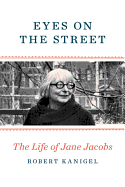
 Jane Jacobs "was not a man. She was not rich. She did not reach public recognition of any magnitude until she was pushing fifty." She did not court publicity, dress well or speak in a thrilling voice. She "wrote seven books, saved neighborhoods, stopped expressways, was arrested twice, basked in the glow of legions of admirers, and had a million discussions and debates around the kitchen table, which she always won." Her influence in urban planning circles continues to this day. In this comprehensive and entertaining three-part biography, Robert Kanigel (On an Irish Island) tells us about Jacobs's background, what she accomplished during her years as a writer and activist in New York City, and how she built another life for herself in Canada, where she wrote her most famous and influential work, The Death and Life of Great American Cities. Kanigel admires Jacobs and he handles her story with respect, humor and scrupulous scholarship, unearthing the solid foundation for her status from the "heaping-up of adulation."
Jane Jacobs "was not a man. She was not rich. She did not reach public recognition of any magnitude until she was pushing fifty." She did not court publicity, dress well or speak in a thrilling voice. She "wrote seven books, saved neighborhoods, stopped expressways, was arrested twice, basked in the glow of legions of admirers, and had a million discussions and debates around the kitchen table, which she always won." Her influence in urban planning circles continues to this day. In this comprehensive and entertaining three-part biography, Robert Kanigel (On an Irish Island) tells us about Jacobs's background, what she accomplished during her years as a writer and activist in New York City, and how she built another life for herself in Canada, where she wrote her most famous and influential work, The Death and Life of Great American Cities. Kanigel admires Jacobs and he handles her story with respect, humor and scrupulous scholarship, unearthing the solid foundation for her status from the "heaping-up of adulation."
Jacobs was born in 1916 into a loving, enthusiastic, nonconformist family and had an independent, forceful personality even as a little girl. In the third grade, she was expelled for lobbying the other children not to take a dental hygiene oath. She didn't want to go to college. When she graduated from high school, she took a secretarial course, plunged into a journalism career and moved to Manhattan's Greenwich Village, where she enjoyed an active social life. She was never beautiful, but it didn't matter because her "personality took over so immediately, her strength of intellect, her antic humor, her eloquence." She took full advantage of the professional opportunities for women during World War II and built a rewarding domestic life with a handsome, creative, intelligent man, who proposed one week after he met her at a party and was entirely supportive of her career.
Despite some skirmishing with the Loyalty Security Board, she worked her way up to a job with Architectural Forum that led to her growing understanding of the gap between urban planning and urban realities, and to an assignment to speak at an urban design conference at Harvard, where she introduced her ideas to influential planners for the first time. "The architectural and planning notions of the postwar period wiped real neighborhoods clean away and supplanted them with places made uniform, inflexible, inhuman, and dull... 'it ought to give planners the shivers.' " Anyone interested in cities or who loves a good biography will enjoy this first-rate story of one of the great independent thinkers of the 20th century. --Sara Catterall
Shelf Talker: This is a comprehensive and evocative biography of a charismatic and influential urbanist, journalist, activist and author.

